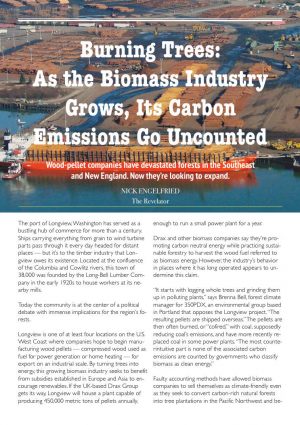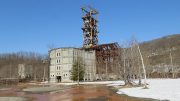 The port of Longview, Washington has served as a bustling hub of commerce for more than a century. Ships carrying everything from grain to wind turbine parts pass through it every day headed for distant places — but it’s to the timber industry that Longview owes its existence. Located at the confluence of the Columbia and Cowlitz rivers, this town of 38,000 was founded by the Long-Bell Lumber Company in the early 1920s to house workers at its nearby mills.
The port of Longview, Washington has served as a bustling hub of commerce for more than a century. Ships carrying everything from grain to wind turbine parts pass through it every day headed for distant places — but it’s to the timber industry that Longview owes its existence. Located at the confluence of the Columbia and Cowlitz rivers, this town of 38,000 was founded by the Long-Bell Lumber Company in the early 1920s to house workers at its nearby mills.
Today the community is at the center of a political debate with immense implications for the region’s forests.
Longview is one of at least four locations on the U.S. West Coast where companies hope to begin manufacturing wood pellets — compressed wood used as fuel for power generation or home heating — for export on an industrial scale. By turning trees into energy, this growing biomass industry seeks to benefit from subsidies established in Europe and Asia to encourage renewables. If the UK-based Drax Group gets its way, Longview will house a plant capable of producing 450,000 metric tons of pellets annually, enough to run a small power plant for a year.
Drax and other biomass companies say they’re promoting carbon neutral energy while practicing sustainable forestry to harvest the wood fuel referred to as biomass energy. However, the industry’s behavior in places where it has long operated appears to undermine this claim.
“It starts with logging whole trees and grinding them up in polluting plants,” says Brenna Bell, forest climate manager for 350PDX, an environmental group based in Portland that opposes the Longview project. “The resulting pellets are shipped overseas.” The pellets are then often burned, or “cofired,” with coal, supposedly reducing coal’s emissions, and have more recently replaced coal in some power plants. “The most counterintuitive part is none of the associated carbon emissions are counted by governments who classify biomass as clean energy.”
Faulty accounting methods have allowed biomass companies to sell themselves as climate-friendly even as they seek to convert carbon-rich natural forests into tree plantations in the Pacific Northwest and beyond. Nowhere are the on-the-ground impacts clearer than in the Southeast, where large wood biomass export projects have operated longer than anywhere else in the United States.
Selling the Biomass Story
The Drax power generating station looms over North Yorkshire, England, tall as a city high-rise. For decades the plant was Western Europe’s largest coal polluter, but in 2003 Drax began converting the first of four boilers to cofire wood. Last year the company finished replacing coal at its plant with wood pellets, hailing the milestone as a step toward a “zero-carbon energy future.”
Communities in the American Southeast, where Drax sources much of the wood for its plant, weren’t celebrating.
“The biomass industry in the Southeast expanded from barely anything 15 years ago to exporting over 9 million tons of wood pellets annually today,” says Adam Colette of Dogwood Alliance, which works to protect southern forests. “We’re talking over 100,000 acres of forest being cleared solely for this purpose every year. And that’s a conservative estimate.”
The South has long been among the most logged regions in the country, but the arrival of biomass companies put new pressure on remaining natural forests. A study commissioned by the Southern Environmental Law Center showed forest loss has increased significantly in the area surrounding biomass pellet plants in Virginia and North Carolina.
“The industry calls biomass a climate solution,” Colette says. “Smart people in government, even some well-intentioned people in the climate movement, support giving it hundreds of billions in subsidies. You’ve got to ask, how is that possible? It’s not that biomass is as powerful as the fossil fuel industry.”
Fossil fuel companies amassed immense political clout over centuries. By contrast, the biomass industry is only decades old. Yet biomass companies have won political favor by peddling a narrative with immense allure for policymakers who want quick fixes to the climate crisis.
On paper, converting existing coal plants to run on wood pellets looks like an easy climate win. But burning wood produces even more carbon than coal per unit of energy generated. Because this carbon can theoretically be reabsorbed if forests grow back, some governments consider the process carbon neutral — but continually cut and regrown forests never achieve the carbon storage potential of older trees. And even if the carbon released during deforestation is eventually reabsorbed, it stays in the atmosphere for decades in the meantime. None of this is accounted for by policymakers who see biomass as green energy.
Nor is it only foreign governments subsidizing the industry. In parts of the United States, too, trees are burned for electricity. Ironically these include jurisdictions that regard themselves as among the world’s greenest.
Burning the Forest
“We’ve been deluded about biomass in Burlington, Vermont,” says Zack Porter, executive director of the New England-based Standing Trees. “We’re supposedly America’s first city to run entirely on carbon-neutral renewable electricity. Yet our leaders tout that title knowing we still rely on Vermont’s largest point source of carbon emissions: the McNeil biomass power plant.”
Burlington’s Joseph C. McNeil generating station pumps close to half a million tons of carbon dioxide into the atmosphere every year but is considered carbon neutral energy under Vermont’s Global Warming Solutions Act. This designation has been justified partly by biomass companies’ claim that they burn mainly “waste wood,” or branches and other tree parts leftover from logging, as well as wood residues such as sawdust.
“The problem is, to timber companies ‘waste’ is any wood they can’t find a higher value use for,” says Porter. “They see old or crooked trees that can’t be sold for lumber as waste. But we actually have a scarcity of ecologically important logs and snags in New England forests, and creating more demand to remove them worsens the problem.” Wildlife species that depend on woody debris for habitat include marbled and Jefferson salamanders, both of whom are considered imperiled across parts of their New England range.
At a hearing in Burlington last year, a proposal to heat University of Vermont medical center buildings with steam from McNeil drew intense opposition, suggesting climate groups have momentum as they push policymakers to rethink the role of biomass in Vermont’s grid.
There would be precedent for such a move. New York and Massachusetts have taken steps to exclude forest biomass from benefiting off clean energy incentives, and advocates like Porter think other Northeast states should follow suit.
In fact, there’s a growing national movement to make climate policies more accurately reflect the carbon footprint of wood biomass, both in U.S. circles and beyond. This goal has taken on increased importance as the industry seeks to expand beyond the South and Northeast into regions where it has yet to establish a major presence.
Stopping the Expansion
Back in Longview, climate activists prepare to fight what could become the state’s first industrial-scale wood-pellet manufacturing plant. Locals plan to speak out against Drax’s Longview project at a hearing expected later this year. Across the Columbia River, 350PDX has been educating the public about impacts of the biomass industry by tabling at public events and hosting a screening of the documentary Burned. Other West Coast biomass plants have also drawn opposition.
At the port of Grays Harbor, two hours’ north of Longview, Pacific Northwest Renewable Energy wants to build a pellet plant comparable in size to the Drax project. Two more plants, with a combined ability to produce about a million tons of pellets annually, are proposed by Golden State Natural Resources in California.
To bolster political support for these plants in green-leaning West Coast states, the companies involved have leaned into a new talking point: that removing “waste” wood from forests will somehow blunt increasingly devastating fire seasons.
“This industry is playing on people’s justified fear of fire,” said Rita Vaughan Frost, an Oregon-based forest advocate with the Natural Resources Defense Council. “But their demand for a product to constantly deliver to customers will actually shift resources away from fire-management regimes based on the best science, such as Indigenous practices that include prescribed burns.”
Despite purporting concern about fire, the biomass industry on the West Coast has proposed doing something very similar to what it’s already done in the Southeast and New England: turning carbon-rich, biodiverse forests into tree plantations whose purpose is to grow wood as fast as possible for conversion into fuel.
Ironically, this is happening even as the climate benefits of intact forests are drawing unprecedented attention.
In December the Biden administration announced it will amend national forest management plans all over the country with the intent of protecting old-growth forests. And in Washington State there’s a growing movement to protect mature “legacy forests” that don’t yet qualify as old growth but provide significant carbon storage benefits. The biomass industry’s goals complicate such efforts.
“I want people to know we have a precious opportunity right now to keep this destructive industry out of our region before it gets established and expands,” says Bell of 350PDX. “We need to focus on that, because if we let them gain a foothold our work will get that much harder.”
Nick Engelfried
Originally published
by The Revelator
May 20, 2024






